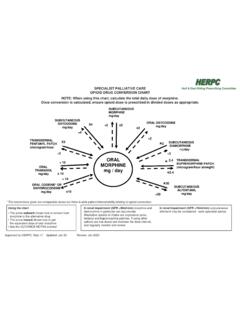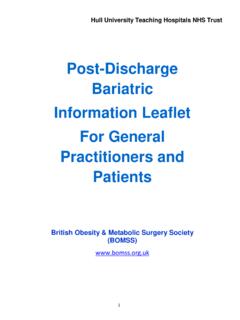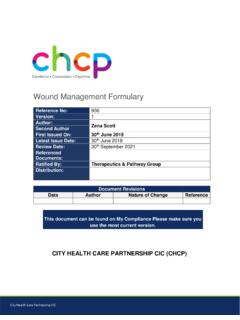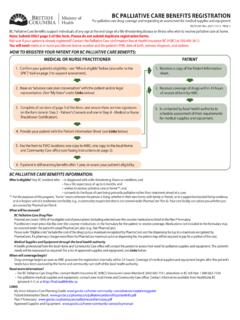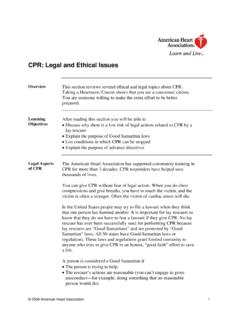Transcription of A Guide to Symptom Management in Palliative Care
1 1A Guide to Symptom Management in Palliative CareSupported by Health Education EnglandVersion 6 Publication date: June 2016 Review date: June 201921 Yorkshire and Humber Palliative and end of life Care GroupsA Guide TO Symptom Management IN Palliative CARECONTENTSI ntroduction: 3 Useful Resources 4 The Use of Medicines Off-Label 5 Principles of Symptom Management 6 Pain Management : 8 Principles 8 Assessment and Review 11 Recommended Medicines 13 Opioid Analgesic Equivalences 26 Nausea and Vomiting 30 Intestinal Obstruction 33 Constipation 37 Breathlessness 39 Delirium 43 2 Palliative Care Emergencies.
2 46 Metastatic Spinal Cord Compression and Vertebral Metastases 46 Superior Vena Caval Obstruction 52 Hypercalcaemia 53 Lymphoedema 56 Mouth Care 58 The Last Days of life 61 Symptoms in Dementia 70 Syringe Pump Principles 73 Subcutaneous Medications 74 Table of commonly used drugs 763 INTRODUCTIONThis guidance covers some of the commonest symptoms in cancer and advanced progressive disease. For the Management of other symptoms not included here, including fatigue, cough, sweating, anorexia and cachexia please see an introductory Palliative care text and refer to the other useful resources listed in the Education England working across Yorkshire and the Humber has sponsored the production of these Symptom Management guidelines which have been produced by the regional Palliative and end of life Care Groups of Yorkshire and Humber.
3 They were updated in March 2016 and reflect a consensus of opinion from specialists working in the field of Palliative medicine in hospitals, hospices and in the Editors:Elaine Boland and Jason BolandGuideline Authors:Lucy Adkinson, Sarah Callin, Annette Clark, Annette Edwards, Vicky Elliot, Clare Farrington, Justin Fernando, Michelle Fleming, Sarah Follon, Elke Fraser, Suzie Gillon, Bill Hulme, Miriam Johnson, Jane Jones, Mary Kiely, Penny Kirk, Suzanne Kite, Hazra Madhubrata, Sarah McDermott, Lisa Nicholson, George Obita, Naomi Penn, Carina Saxby, Rachel Sorley, Chris Toothill, Jason These guidelines are the property of the Yorkshire and Humber Palliative and end of life Care Groups.
4 It is intended that they be used by qualified medical and other healthcare professionals as an information resource, within the clinical context of each individual patient s needs. The groups take no responsibility for any consequences of any actions taken as a result of using these guidelines. Readers are strongly advised to ensure that they are acting in line with current accepted practice and legislation, as these may change. These include, but are not limited to, the NICE guidance on the prescription of opioids, the British National Formulary (BNF) and the Palliative Care Formulary (PCF). No legal liability is accepted for any errors in these guidelines, or for the misuse or misapplication of the advice presented here.
5 In difficult situations, please seek advice from your local Specialist Palliative Care ResourcesDetails are given here of selected widely used medicines. See also BNF sections on Controlled Drugs and Prescribing in Palliative Care . Check the BNF for formulations, dose recommendations, side effects and useful resources are: Local intranet guidelines The latest version of: The Palliative Care formulary (PCF). Twycross R, and Wilcock A, Radcliffe Medical Press Ltd and website NICE website, 5 GMC guidelines, Treatment and care towards the end of life : good practice in decision making , (2010), Use of Medicines Beyond (Off-Label) and Without Marketing AuthorisationThe use of medicines for off-label purposes is necessary when the clinical need cannot be met by the specifications of its marketing authorisations (MA), for an unauthorised indication, or in doses, preparations, patient population or route not covered by the MA.
6 The recommendations within this Symptom Management Guide include the off-label use of authorised medicines. These recommendations are based on current accepted Palliative care practice in the UK. In practice, approximately 25% of medicines prescribed for Palliative care patients are used off-label ( when given by subcutaneous injection when only licensed for IM or IV use; for the treatment of nausea and vomiting when only licensed as an antipsychotic; or when mixing medicines in a syringe before administration by continuous infusion). Further information regarding off-label use of individual Palliative care medicines can be found in the current version of the unauthorised medicines, or authorised medicines for off-label indications, may carry significant risks.
7 The prescriber signing the prescription takes full responsibility. When prescribing medicines off-label, it has been suggested that the prescriber should: discuss with the patient and document in the patient s records 6the reason why they are using the medicine off-label; where appropriate, gain informed consent from the patient; inform nurses and pharmacists to avoid misunderstandings where necessary; and give the patient a written leaflet where appropriate. A suitable leaflet may be downloaded from: In practice, recording every unlicensed use may be impractical and gaining informed consent in every instance may lead to unnecessary anxiety for the patient or carer.
8 Practitioners must follow their clinical judgment on the balance of potential burden and benefit and their own organisation s policy on the use of authorised medicines for off-label purposes. Principles of Symptom Management1 . Remember to consider the whole patient . Symptoms are rarely purely physical or purely psychological, and all symptoms and treatments impact on the patient, their family and friends. 2 . Evaluate symptoms thoroughly. Consider potential causes and remember to consider causes other than the underlying condition. Consider the impact of the Symptom on the patient s quality of life . 3 . Effective communication is essential. Explain in simple terms and avoid medical jargon.
9 Discuss treatment options with patients and their families, and involve them in the Management plan. 74 . Correct the correctable, as long as the treatment is practical and not overly burdensome. Remember non-drug treatments, Palliative radiotherapy for metastatic bone pain. 5 . Remember to consider non-pharmacological strategies to help relieve symptoms simple repositioning, or the use of a TENS machine may help pain; complementary therapies may help psychological distress. Although the evidence base for such treatments is not robust, some patients find them helpful. 6 . When using drug treatments for persistent symptoms, give regularly and also as needed ( ). Keep drug treatment as simple as possible.
10 7 . Review regularly and adjust treatment. 8 . Plan in advance. Good communication is essential in establishing patients wishes for their future care and treatment. Patients may want to document their wishes the Preferred Priorities for Care document (available from ) or an Advance Decision to Refuse Treatment may be helpful. 9 . Keep other staff informed. 10. Ask for help. Refer to local guidelines or speak to the local Specialist Palliative Care team (SPCT). Refer to GMC guidelines (see Useful Resources, page 4). 8 SECTION A: PRINCIPLES OF PAIN MANAGEMENT1 . Pain is common in advanced cancer and non-malignant conditions, and its Management can be difficult. 2 . Pain is a total, personal experience with physical, psychological, social and spiritual dimensions.

